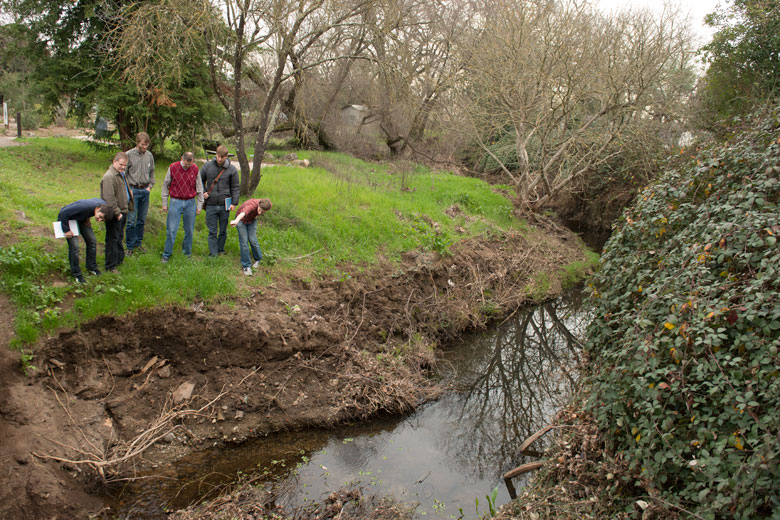
Screenshot from video by Ian Fitzgerald and Rob Jordan: Stanford researchers are working with local and federal agencies in Los Angeles, Sonoma and other drought-stricken California cities in an unprecedented effort to capture and reuse stormwater.
Stanford Report - September 16th, 2015 - by Rob Jordan
Down the drain. It's a phrase synonymous with lost opportunities. In semiarid regions, opportunity for improved water supply and security literally goes down the drain every time episodic rainstorms pass through.
To take advantage of this rainfall, Stanford researchers are working with local and federal agencies in Los Angeles, Sonoma and other drought-stricken California cities in an unprecedented effort to capture and reuse stormwater. The approach could be part of a solution not only to water shortages but also to runoff laced with pesticides and other chemicals that can contaminate beaches and contribute to fish-killing algae blooms.
"These are billion-dollar problems," said Richard Luthy, the Silas H. Palmer Professor of Civil and Environmental Engineering at Stanford, and senior fellow at the Stanford Woods Institute for the Environment. "Meeting water needs in the future is going to depend a lot on how we reuse water and what we do with stormwater."

Photo by L.A. Cicero: Professor Richard Luthy and a team of graduate
students survey a creek in Sonoma County, Calif., as part of a study on
stormwater capture and reuse.
Luthy co-directs the Engineering Research Center for Re-Inventing the Nation's Urban Water Infrastructure (ReNUWIt), which identifies new ways to supply urban water and treat wastewater efficiently and sustainably. ReNUWIt, a partnership of multiple universities and private industry under a National Science Foundation agreement, grew out of research funded by the Stanford Woods Institute's Environmental Venture Projects seed grant program. Among ReNUWIt's major initiatives is the Codiga Resource Recovery Center, a water reclamation research facility under construction on Stanford's campus.
Conservation alone will not be sufficient to meet the demands of arid regions' growing populations. Reusing stormwater captured in just two metropolitan areas – San Francisco and Los Angeles – has the potential to fulfill the annual indoor water demand of about 10 million people, Luthy said.
"If people don't embrace reuse projects, what choices will they have to make?" said Greg LeFevre, a postdoctoral scholar in Luthy's lab. "There needs to be a broad range of solutions. Stormwater reuse is one of those."
In October 2014, California passed legislation to encourage capture and use of stormwater. As of 2012, an estimated 670,000 acre-feet (1 acre-foot = an acre of foot-deep water) of municipal wastewater were already being reused in the state each year, according to the California Department of Water Resources. Los Angeles plans to rely on stormwater capture for nearly 10 percent of its total water supply in the next 20 years as part of an ambitious project to reduce by half the amount of water the city imports.
In most places though, stormwater runoff is channeled directly to a body of water such as a lake, bay or ocean. The Los Angeles River, a heavily engineered, concrete-lined waterway famous for Hollywood car chase scenes, is an iconic example of such a system. Current stormwater recovery technologies are better suited to frequent, low-intensity storms, not the episodic downpours common to regions such as the American West.
Luthy and his team are helping develop a project that would convert 46 acres of abandoned quarry into a park that doubles as a stormwater capture and treatment facility. It will provide rare green space in a low-income neighborhood full of salvage yards and auto body shops. The Los Angeles County Flood Control District put $18 million toward the purchase of the site, and the City of Los Angeles paid the remainder of the $28 million cost. For construction of the stormwater facility, the flood control district will contribute about $44 million, and the city will put in $7.8 million.
In Northern California, the city of Sonoma recently stopped releasing water to the San Francisco Bay, and committed to reusing all treated wastewater in projects such as salt ponds restoration and school grounds' irrigation.
"Our water resources are being more and more constrained and strained," said Kent Gylfe, principal engineer with Sonoma County's water agency. "We want to be more innovative and make the best use of our resources."
Luthy and other ReNUWIt researchers from the University of California, Berkeley are outfitting a building at the Sonoma Valley Wastewater Treatment Plant to test various processes for removal of nutrients and other contaminants from stormwater. The researchers are also examining city planning, implementation factors and community preferences to identify the best sites in Sonoma for locating stormwater capture, treatment and groundwater recharge systems. The initiative aims to provide communities with a template for stormwater capture and treatment systems that operate with minimal upkeep, double as parkland, recharge underground aquifers and restore ecosystems.
In concert with their projects in Los Angeles, Sonoma and elsewhere, Luthy and his ReNUWIt colleagues are developing systems that capture and cleanse stormwater before recharging it into an underground aquifer. In one such system, as water passes through a vegetated capture pond, which doubles as an animal habitat, sunlight deactivates some waterborne pathogens and organic contaminants. A combination of natural or charcoal-based filters removes additional contaminants, such as nitrates, phosphorus and agrochemicals. Weather forecasts inform sensors and actuators how long the pond should hold water, and the speed at which water is filtered to optimize pollutant removal before routing it into a groundwater aquifer.
It's part of a larger stormwater reuse vision that includes strategically managed wetlands, groundwater replenishment systems, and innovative basins or street-side filters that can augment local urban water supplies.
"These will be a combination of natural systems," Luthy said. "But make no mistake, they'll also be engineered systems."

